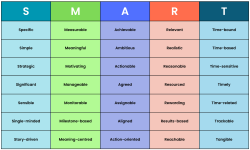18th July 2025
It’s Time to Get SMART on Crafting Goals
I was recently working with a group of senior leaders gearing up for a strategic reset. We’d just kicked off a session focused on setting impactful organisational goals. I asked:
“How will you know your goals are well-formed?”
One leader leaned in confidently: “They’ll be SMART goals.” Heads nodded in agreement.
Then I asked, “What does SMART stand for?”
The room fell into an odd silence, followed by a flurry of answers. One said “Specific, Measurable, Achievable…” Another chimed in with “Agreed.” Someone else said “Ambitious.” There were at least three versions of “R” and four for “T.”
No two leaders had the same definition.
Here lies the problem.
SMART is one of the most widely adopted frameworks in goal setting, but unlike most frameworks, it has no consistent definition in practice. That’s more than a quirk. It’s a leadership issue.
Leaders are supposed to bring clarity, direction, and alignment. But when the most fundamental goal-setting language is open to interpretation, we introduce confusion where precision is needed most.
Let’s rewind to where this all started.
The SMART framework was introduced by George T. Doran in a 1981 article in Management Review. His version was:
- Specific
- Measurable
- Assignable
- Realistic
- Time-related
He was also careful to state that not every objective needs to meet all five criteria. It was meant as a guide, not a checklist.
Over the decades, SMART has evolved beyond recognition. Each letter now wears multiple hats, depending on who’s using it.
Today, SMART can mean any combination of:
 That flexibility might sound helpful. But in reality? It’s organisational CHAOS (yes, that’s a gratuitous Get Smart pun).
That flexibility might sound helpful. But in reality? It’s organisational CHAOS (yes, that’s a gratuitous Get Smart pun).
Don’t dilute clarity
If one leader designs goals that are Strategic, Measurable, Ambitious, Results-based, and Trackable…
…and another manager uses Simple, Motivating, Achievable, Reasonable, and Timely…
…they’re speaking different dialects of the same language without even knowing it.
When this happens across an organisation, SMART doesn’t deliver clarity. It dilutes it.
And when new managers inherit teams or shift companies, they bring their own interpretations with them. What was “Agreed” in one culture becomes “Ambitious” in another. The end result? Misalignment dressed up as best practice.
So, what’s the alternative?
Keep SMART if it serves you. But don’t assume it’s universally understood. If you want goals that can stand the test of culture, context, and leadership change set Binary Goals.
Binary goals are ones where the answer to the question “Did you do it?” is either yes or no.
Binary Goals are:
- Action-focused
- Outcome-driven
- Immune to interpretation
They are, by nature, Specific, Measurable, Assignable, Realistic, and Time-related regardless of what version of SMART you subscribe to.
And most importantly, they leave no room for ambiguity.
Leaders: your job is not to create clever acronyms.
It’s to create alignment. To reduce confusion. To drive performance.
You’ve probably been working with SMART goals for years. Maybe it’s time to make them Binary.
Because clarity isn’t a nice-to-have. It’s a leadership responsibility.
And the goal of goal setting? Isn’t just to check boxes. It’s to get things done.
Categories: Uncategorised



